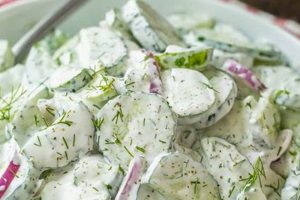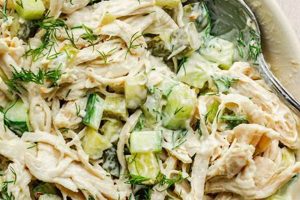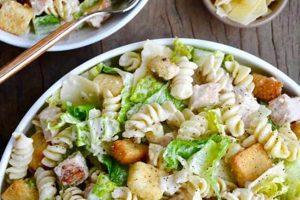A dish featuring cooked chicken, typically shredded or diced, combined with mayonnaise and other ingredients, is enhanced by the addition of honey mustard. This sweet and tangy condiment contributes a distinctive flavor profile, balancing the richness of the mayonnaise and complementing the savory chicken. Variations can include the addition of celery, grapes, nuts, onions, or other fruits and vegetables.
The blend of flavors and textures offered by this combination makes it a versatile option for sandwiches, wraps, salads, or as a standalone appetizer. The relative ease of preparation and readily available ingredients contribute to its popularity. Historically, chicken salad emerged as a popular dish in the mid-19th century, evolving alongside advancements in refrigeration and mayonnaise production. The incorporation of honey mustard adds a contemporary twist to this classic dish.
Further exploration will delve into specific ingredient selections, preparation techniques, variations, and serving suggestions to showcase the versatility and appeal of this culinary creation.
Tips for Creating Exceptional Chicken Salad with Honey Mustard
Achieving optimal flavor and texture requires attention to detail throughout the preparation process. These tips offer guidance for crafting a superior chicken salad experience.
Tip 1: Chicken Selection and Preparation: Opt for high-quality, boneless, skinless chicken breasts. Poaching or roasting the chicken yields optimal moisture and flavor. Avoid overcooking, as this can result in dry, stringy meat. Allow the chicken to cool completely before shredding or dicing to prevent the mayonnaise from melting.
Tip 2: Mayonnaise and Honey Mustard Ratio: Balance is key. Start with a classic ratio of two parts mayonnaise to one part honey mustard. Adjust according to personal preference, adding more honey mustard for increased tanginess.
Tip 3: Ingredient Incorporation: Gently fold ingredients together to avoid crushing delicate components like grapes or celery. Overmixing can result in a mushy texture.
Tip 4: Freshness of Ingredients: Utilize crisp, fresh produce for optimal flavor and texture. Wilted celery or bruised grapes can detract from the overall quality.
Tip 5: Seasoning Considerations: Enhance the flavor profile with a pinch of salt, black pepper, or a dash of paprika. Taste and adjust seasonings as needed before serving.
Tip 6: Chilling and Serving: Allow the chicken salad to chill for at least 30 minutes before serving. This allows the flavors to meld and enhances the overall experience. Serve chilled on bread, crackers, croissants, or lettuce wraps.
Tip 7: Texture Variation: Incorporate textural elements for added interest. Chopped nuts, such as pecans or walnuts, offer a satisfying crunch. Sliced grapes or dried cranberries provide a burst of sweetness and a pleasant chewiness.
By following these guidelines, one can elevate chicken salad from a simple dish to a culinary delight. Attention to these details ensures a balanced and flavorful experience.
These tips offer a foundation for creating a memorable chicken salad. Experimentation and adaptation to individual preferences are encouraged to discover personalized variations.
1. High-quality Chicken
The foundation of exceptional chicken salad rests upon the quality of its primary ingredient: chicken. High-quality chicken contributes significantly to the overall flavor, texture, and nutritional value of the final dish. Selecting and preparing the chicken thoughtfully elevates a simple chicken salad recipe with honey mustard to a culinary experience.
- Flavor Enhancement
Chicken possessing inherent flavor translates directly to a more flavorful salad. Fresh, properly handled chicken offers a clean, savory taste that complements the other ingredients, rather than requiring excessive seasoning to mask blandness. Free-range or organic chicken, often perceived as higher quality, may offer richer, more nuanced flavors.
- Textural Impact
High-quality chicken exhibits a firm, yet tender texture. Overly processed or poorly handled chicken can result in a stringy, rubbery, or dry consistency that detracts from the salad’s appeal. Chicken that has been carefully cooked and properly chilled maintains its integrity, contributing a pleasant mouthfeel.
- Nutritional Considerations
Chicken serves as a source of lean protein. High-quality chicken often correlates with healthier farming practices and reduced exposure to antibiotics or hormones. These factors can influence the nutritional profile of the final dish. Opting for lean chicken breast minimizes fat content while maximizing protein.
- Overall Culinary Experience
The cumulative impact of superior flavor, pleasing texture, and nutritional value elevates the entire dining experience. Investing in high-quality chicken ensures that the chicken salad, enhanced with honey mustard, becomes more than just a simple meal. It becomes a satisfying and enjoyable culinary creation.
The selection of high-quality chicken demonstrates a commitment to excellence, transforming a basic chicken salad recipe with honey mustard into a dish showcasing both flavor and culinary appreciation. Discerning palates will recognize and appreciate the nuanced difference that premium chicken provides.
2. Balanced Honey Mustard
Balanced honey mustard plays a crucial role in a chicken salad recipe. The interplay of sweet honey and tangy mustard provides a complex flavor profile that complements the savory chicken and other ingredients. An unbalanced honey mustard, leaning too heavily towards sweetness or acidity, can disrupt the overall flavor harmony. For example, an overly sweet honey mustard might overpower the subtle flavors of celery or grapes, while an excessively tangy mustard could clash with the richness of the mayonnaise. The balance achieved in the honey mustard acts as a bridge, unifying the diverse flavors within the salad.
The concept of balance extends beyond mere flavor. The honey in honey mustard contributes a subtle sweetness and a smooth texture, while the mustard provides a sharp bite and a touch of heat. This textural contrast enhances the overall sensory experience of the chicken salad. Consider a chicken salad featuring crisp celery, crunchy pecans, and juicy grapes. A balanced honey mustard enhances these contrasting textures, creating a more dynamic and enjoyable culinary experience. Conversely, a poorly balanced honey mustard, whether too thick or too thin, can negatively impact the salad’s texture, resulting in a dish that is either cloying or watery.
Achieving a balanced honey mustard requires careful consideration of the specific ingredients used in the chicken salad recipe. A salad with milder ingredients, such as poached chicken and seedless grapes, might benefit from a honey mustard with a more pronounced tang. Conversely, a salad incorporating bolder flavors, like roasted chicken with onions and cranberries, might require a honey mustard with a more restrained tang and a touch more sweetness. Understanding this interplay allows for a tailored approach, maximizing the synergy between the honey mustard and the other components of the chicken salad.
3. Fresh Ingredients
Fresh ingredients are essential for a high-quality chicken salad with honey mustard. Their vibrancy elevates the dish beyond simple sustenance, contributing significantly to flavor, texture, and overall appeal. The quality of ingredients directly impacts the final product, highlighting the importance of freshness in creating a truly exceptional culinary experience.
- Enhanced Flavor Profiles
Fresh ingredients possess vibrant, distinct flavors that contribute complexity and depth to the chicken salad. Consider the crisp, clean taste of freshly chopped celery versus its limp, less flavorful counterpart. Similarly, plump, juicy grapes burst with sweetness, contrasting with the savory chicken and tangy honey mustard. Fresh herbs, such as dill or chives, offer bright, aromatic notes that enhance the overall flavor profile.
- Optimal Texture and Mouthfeel
Fresh ingredients contribute to a desirable textural complexity. Crisp celery and onions provide a satisfying crunch, contrasting with the tender chicken and creamy dressing. Juicy grapes or plump dried cranberries offer a burst of moisture and a pleasant chewiness. The combination of these varying textures creates a more dynamic and enjoyable eating experience.
- Visual Appeal and Presentation
The vibrant colors and crisp appearance of fresh ingredients enhance the visual appeal of the chicken salad. Bright green celery, deep red grapes, and vibrant herbs create an appetizing presentation. This visual appeal contributes to the overall dining experience, making the dish more enticing and enjoyable.
- Nutritional Value and Health Benefits
Fresh ingredients retain optimal nutritional value. Vitamins and antioxidants are more readily available in produce that has been recently harvested. Incorporating fresh, nutrient-rich ingredients into the chicken salad enhances its health benefits, contributing to a more wholesome and nourishing meal.
The emphasis on fresh ingredients elevates the chicken salad with honey mustard from a simple combination of components to a cohesive culinary creation. Prioritizing freshness ensures a vibrant and flavorful dish that is both satisfying and enjoyable. This attention to quality underscores the difference between a merely adequate chicken salad and a truly exceptional one.
4. Proper Chilling
Proper chilling is a crucial step in preparing chicken salad with honey mustard, significantly impacting food safety and enhancing flavor development and textural integrity. Chilling affects not only the individual ingredients but also their harmonious interaction within the final dish. Neglecting this step can compromise the overall quality and enjoyment of the chicken salad.
- Food Safety
Chilling inhibits bacterial growth, a critical concern with perishable ingredients like chicken and mayonnaise. Maintaining a safe temperature below 40F (4C) minimizes the risk of foodborne illnesses. Promptly chilling the cooked chicken and then the finished salad safeguards against bacterial proliferation.
- Flavor Melding
Chilling allows the diverse flavors of the chicken, honey mustard, and other ingredients to meld and harmonize. The cool temperature slows down chemical reactions, allowing the flavors to subtly intertwine and mature over time. A properly chilled chicken salad exhibits a more balanced and nuanced flavor profile compared to one consumed immediately after preparation.
- Texture Enhancement
Chilling firms the chicken and stabilizes the mayonnaise-based dressing, contributing to a more desirable texture. A chilled salad holds its shape better, preventing a watery or runny consistency. This is particularly important for serving the salad in sandwiches, wraps, or on crackers, where structural integrity is essential.
- Overall Quality Enhancement
The combined impact of enhanced food safety, flavor development, and textural improvement contributes to a superior culinary experience. Proper chilling elevates the chicken salad from a simple mixture of ingredients to a carefully crafted dish. Attention to this detail demonstrates a commitment to quality and ensures a more enjoyable and satisfying meal.
Proper chilling, therefore, is not merely a procedural step but an integral part of crafting a high-quality chicken salad with honey mustard. It represents a fundamental principle of culinary practice, ensuring both safety and an enhanced sensory experience. By understanding the impact of chilling, one can appreciate its crucial role in creating a truly exceptional dish.
5. Textural Variety
Textural variety significantly contributes to the overall enjoyment of chicken salad with honey mustard. A dynamic interplay of textures elevates the dish beyond a simple combination of ingredients, creating a more engaging and satisfying sensory experience. This textural complexity arises from the thoughtful incorporation of ingredients with contrasting consistencies.
Consider the foundational elements of a typical chicken salad: tender, shredded chicken and a creamy, smooth dressing. While these components provide a pleasant baseline, the addition of contrasting textures significantly enhances the overall appeal. Crisp elements, such as finely diced celery or red onion, introduce a refreshing crunch. The incorporation of nuts, like toasted pecans or walnuts, offers a satisfying contrast to the softer elements. Adding chewy dried cranberries or sweet, juicy grapes further diversifies the textural profile. The interplay of these contrasting textures creates a more dynamic and stimulating mouthfeel.
The absence of textural variety can result in a monotonous eating experience. A chicken salad consisting solely of shredded chicken and mayonnaise, even with the added flavor of honey mustard, can feel heavy and one-dimensional. The introduction of contrasting textures, however, transforms the dish. Each bite offers a new and exciting interplay of sensations, preventing palate fatigue and enhancing enjoyment. This textural complexity is essential for elevating a basic chicken salad recipe with honey mustard into a truly memorable culinary experience. Understanding the importance of textural variety empowers one to create a more balanced and satisfying dish.
6. Creative Serving
Creative serving elevates chicken salad with honey mustard beyond a simple meal, transforming it into a memorable culinary experience. Presentation contributes significantly to enjoyment, impacting visual appeal and perceived value. Thoughtful serving methods enhance the dining experience, showcasing the versatility of this classic dish.
- Beyond the Sandwich
While classic sandwich preparations remain popular, exploring alternative serving methods expands culinary horizons. Chicken salad nestled within crisp lettuce cups offers a lighter, refreshing alternative. Utilizing endive spears or bell pepper halves provides visually appealing and naturally portioned servings.
- Elevating Appetizers and Hors d’oeuvres
Chicken salad translates seamlessly into elegant appetizers. Spooning the salad onto crackers, baguette slices, or miniature phyllo cups creates bite-sized portions ideal for gatherings. Garnishing with fresh herbs or a sprinkle of paprika enhances visual appeal. These elegant presentations transform a simple chicken salad into a sophisticated appetizer.
- Incorporating into Main Courses
Chicken salad can become the centerpiece of a larger meal. Serving atop a bed of mixed greens with complementary fruits and vegetables transforms it into a satisfying salad. Incorporating the salad into croissants or puff pastry shells creates a more substantial, visually appealing main course. These creative presentations add an element of sophistication to a familiar dish.
- Presentation and Garnishing
Thoughtful plating and garnishing elevate the visual appeal. Utilizing attractive serving dishes and incorporating colorful garnishes, such as fresh herbs, edible flowers, or a drizzle of balsamic glaze, transforms a simple dish into a culinary masterpiece. Attention to detail demonstrates culinary expertise and enhances the dining experience.
Creative serving methods enhance the versatility and appeal of chicken salad with honey mustard. Moving beyond traditional presentations elevates the dish, showcasing its adaptability and transforming a simple meal into a memorable culinary experience. The considered presentation adds value, appealing to both the visual and gustatory senses.
Frequently Asked Questions
This section addresses common inquiries regarding chicken salad prepared with honey mustard, offering concise and informative responses.
Question 1: What type of chicken is best suited for chicken salad?
Boneless, skinless chicken breasts are generally preferred for their ease of preparation and consistent texture. However, rotisserie chicken offers a convenient alternative, providing a richer, pre-cooked flavor profile.
Question 2: Can honey mustard be made from scratch?
While pre-made honey mustard offers convenience, preparing it from scratch allows for customized flavor profiles. Combining honey, mustard, mayonnaise, and optional seasonings like vinegar or spices allows for tailored sweetness and tanginess.
Question 3: How long can chicken salad with honey mustard be stored?
Properly stored in an airtight container in a refrigerator at or below 40F (4C), chicken salad typically remains safe to consume for up to three to five days. However, quality may degrade over time.
Question 4: What are common additions to enhance chicken salad with honey mustard?
Common additions include chopped celery, red onion, grapes, dried cranberries, toasted pecans, walnuts, or apples. These ingredients contribute textural variety and complementary flavors.
Question 5: Can frozen chicken be used for this recipe?
While not ideal, frozen chicken can be used if thawed completely and properly cooked before incorporating into the salad. Ensure the chicken reaches an internal temperature of 165F (74C) to eliminate potential food safety risks.
Question 6: How can one adjust the sweetness or tanginess of the salad?
Adjusting the ratio of honey to mustard in the dressing directly impacts sweetness and tanginess. Adding a touch of apple cider vinegar can enhance tang, while a pinch of sugar can increase sweetness. Taste testing and incremental adjustments are recommended.
These responses provide foundational knowledge for preparing and enjoying chicken salad with honey mustard. Experimentation and personalized adjustments are encouraged to achieve optimal flavor preferences.
For further exploration, detailed recipes and serving suggestions are available in subsequent sections.
Chicken Salad Recipe with Honey Mustard
Exploration of this culinary combination reveals the interplay of key elements contributing to a successful outcome. High-quality chicken provides a foundational flavor base. Balanced honey mustard contributes a nuanced interplay of sweet and savory notes. Fresh ingredients enhance both flavor and textural complexity. Proper chilling ensures food safety while allowing flavors to meld. Textural variety elevates the sensory experience. Creative serving methods transform a simple dish into a culinary statement.
Chicken salad enhanced with honey mustard represents more than a mere recipe; it embodies a culinary philosophy emphasizing quality ingredients, balanced flavors, and thoughtful preparation. This exploration encourages culinary experimentation and personalized adaptations, fostering an appreciation for the nuanced interplay of flavors and textures within this versatile dish.






